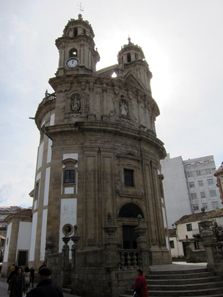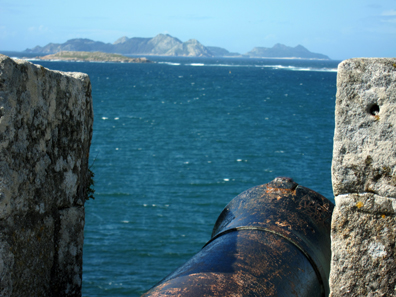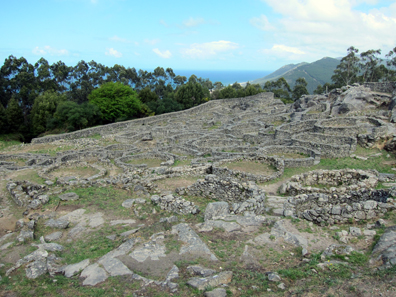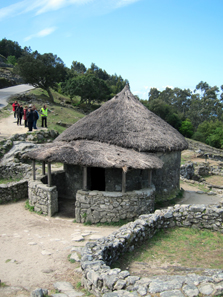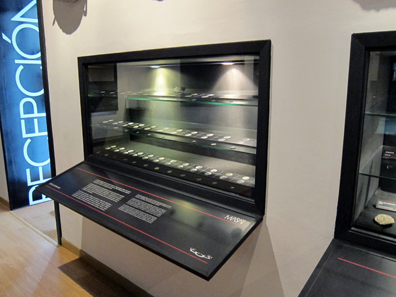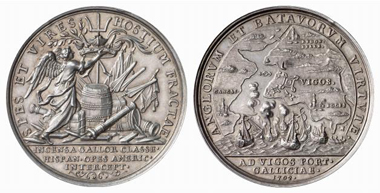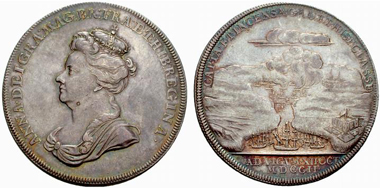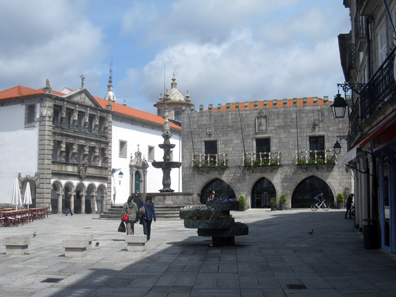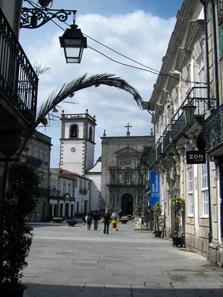by Ursula Kampmann
August 23, 2012 – The English are said to have captured 1,500,000 pounds sterling during their attack of Vigo. That’s a lot of silver! More than enough to make us want to take a peek at the shallow waters of the cove for ourselves in the hopes that something had been left over …
Wednesday April 12, 2012
When we woke up this morning, there were actually bits of blue peeking through the cloud cover; it had finally stopped raining! We had a quick breakfast and hurriedly left Santiago, hoping to take advantage of the weather to drive out to the coast. Our destination – the seaport of Baiona, on the Portuguese coast.
The strangely shaped Igrexa de Peregrina in Pontevedra – a stop on the Portuguese Way of Saint James. Photo: KW.
We started off on the country road towards Pontevedra, a lovely little provincial town with a cathedral, quite a few churches and arcades. It was very pleasant, but by no means a ‘must see,’ even if legend does have it that the city was founded by Teukros, a hero of the Trojan War. Incidentally, Pontevedra gets its name from a Roman relic, the old bridge, which is Pontis Veteris in Latin.
The now silted-up port enjoyed its heyday during the late Middle Ages and Early Modern Age. The corned sardines produced here made a tasty meal for countless Catholics during the many days of fasting on the liturgical calendar.
Replica of the Pinta. Photo: KW.
From Pontevedra we drove on to the spectacular coast with its wide expanses of bays. We spotted the legendary Vigo from the highway, but since we couldn’t stop, figured we’d wait and save it for later.
Baiona, also once an important port, was just one bay away. This is where the Pinta landed, the fastest of the ships of Columbus’ fleet. It’s from the Pinta that Rodrigo de Triana is said to have first spotted the New World. Columbus, however, claimed this discovery for himself in his logbook, preventing the simple seaman from getting to enjoy the lifelong pension that the Catholic kings had offered as a reward.
Today a replica of the Pinta sits in the Baiona harbour, a reminder of its landing in Baiona on March 3, 1493 and being the first to bring news of the New World to Spain.
A look at the enormous parador. Photo: KW.
The harbour is protected by a mighty fort called Monte Real, which also houses the city’s parador. I have to admit that it was pretty impressive. We had to drive through a narrow gate, where a guard checked if we had a reservation. We did, so we gave him our name and fortunately he found us on the reservation list and let us drive through.
A view over the canons. Photo: KW.
The parador was truly breathtaking. It also boasts a wonderful history. Viriatus, the freedom fighter of the Celtic Lusitanians, is said to have defeated the Romans here in the year 140 BC. There’s also another story about an Austrian prince who was locked up here and always covered his face with an iron mask. Whatever stories abound, actual historical fact tells us that the parador is named after a governor of the fortress, Don Diego Sarmiento de Acuna, Count of Gondomar, who is more fondly referred to in popular historical books as ‘the diabolical plotter of the papists.’
For a small additional charge we got a room with an ocean view. We looked out over the battlements of the fortress walls at the blue waves and listened to the gulls (who also proved themselves to be full-blown gourmands – they devoured the treats we’d brought as travel snacks from Basel).
A view of A Guara. Photo: KW.
We didn’t stay at the parador too long though, since we’d learned enough by now to know to take advantage of the blue skies. We jumped in the car and drove along the coast to A Guara, which has one of the best excavated Castro settlements, much like the one we already saw in Viladonga.
In comparison to Viladonga’s small and neat layout, however, the settlement of Santa Trega is simply huge. Apparently only a fifth of it was exposed during the excavations of 1913. According to modern estimates, between 3000 and 5000 people may once have lived here.
Reconstruction of a house. Photo: KW.
Because the coast is full of vacationers in the summer, Santa Trega grew into an attraction also popular with families with children. There are two reconstructed houses here that you can visit. They’re so small that you have to wonder how so many people could actually have lived in them.
Gold object with Ibero-Celtic cartouches. Photo: KW.
Not only is there a pilgrimage church up on the mountain, there’s also an accompanying museum. Once again, we were warmly received – another stupid sign saying ‘no photos allowed.’ By now, though, I’d become crafty, and asked nicely if I could take pictures without flash. The man at the information desk said we could gladly take photos, with or without flash.
Display case with found coins. Photo: KW.
As it happens, there was also a display case here with coins found during the excavation.
We got back to Baiona at a quarter after three. Having adjusted to the later mealtimes by now, we did as the Spaniards do and had a little in-between-lunch-and-dinner meal. As always, it was huge and extremely delicious (although someone should tell the cook that white asparagus should be peeled before cooking).
A late Easter bunny. Photo: KW.
After eating, we spent almost two hours exploring the star fort that houses our parador. We saw hares and lizards, balanced on narrow walls and sat on sunny benches to look out at the choppy sea. The sun did us some good and the wind was lovely. If only we’d had such beautiful weather every day …
Friday April 13, 2012
After enjoying the best breakfast buffet of the entire trip so far, it was off to Vigo. Finally, a numismatic tour!
1702 silver medal, by P. H. Müller, unsigned, of the annihilation of the Spanish-French fleet at Vigo. From Künker auction 116 (2006), 4089.
The Britons and their Dutch allies had, in fact, pursued a very strategic objective – they wanted to use Cadiz as a bridgehead for their military actions in the Spanish War of Succession. Remember? Or is your knowledge of the Spanish War of Succession a bit hazy (or perhaps it never made it onto your history teachers’ lesson plans)? Whatever the case, here’s a quick overview to bring you back up to speed – after the death of the last Spanish Habsburg, an alliance of Austrian Habsburgs, English and Dutch battled against Louis XIV, who desperately wanted to get his grandson onto the throne. He managed to do this, but not without dragging France into financial ruin.
Anna. Crown 1703, London. Dav. 1338. From Künker auction 184 (2011), 5445.
At any rate, the English fleet’s attempted assault at Cadiz proved a disaster. But while they were still fretting over this failure, the admiral received news that the Spanish silver fleet from America had anchored at Vigo bay, protected by French ships. The unloading of the mass quantities of silver was progressing slowly, since the royal officials in charge of overseeing the unloading first had to travel from Seville and Cadiz, where the fleet normally dropped anchor.
The English fleet sailed immediately to Vigo, reaching the deeply indented bay on the evening of October 22. They sailed past the two forts at the entrance of the city in order to get to the end of the bay where the silver fleet was anchored. This area had been blocked by a large boom made out of timber and metal chains and had been secured by a battery of canons. On October 23, the Britons succeeded in landing soldiers who put the Spanish garrisons of the forts out of commission. The canon fire ceased, and the most powerful English battleship floated through the harbour barriers. With that, the path to the silver had been cleared.
Anna. Silver medal 1702. Rv. Burning ships in the Vigo Harbour. From UBS auction 69 (2007), 2716.
The French guards set the silver fleet ships ablaze in an attempt to prevent the English from getting their hands on the treasures. Some of the precious metal was salvaged, but some of the ships sank along with the valuable freight (and still lie in wait to be lifted out of the water someday). The loss of valuables was a blow not only to the Spanish government, but also to the many private merchants who had transported their goods with the fleet. It also elicited mixed feelings in the Netherlands, where they had maintained close business relations with their Spanish colleagues.
The matter of just how much silver the English managed to get their hands on is a contentious one. Some sources say it was 1,500,000 pounds sterling. And yet Sir Isaac Newton, at that time a mint master in London, noted that he only received 4.504 pounds 2 oz. silver (ca. 2.043 kg), which he estimated at around 14,000 pounds. But for the purposes of propaganda, the larger number was obviously much more useful! Regardless, the English celebrated their victory at Vigo and had coins minted from the silver they’d captured (which may or may not have been augmented by local supplies). These coins have the prominent inscription ‘VIGO’.
A view of the Bay of Vigo – today there’s a bridge where the naval blockade of timber and chains must have been. Photo: KW.
All of this was in the back of our heads as we drove to Vigo, so it is important to mention that the actual city no longer has any resemblance to the city we’d dreamt up. Vigo is one of Spain’s most important ports. It’s also the biggest fishing harbour in Europe and has its largest fishing industry and largest canned fish factory. What’s more, Peugeot Citroen manufactures half a million cars here every year (although this number may now have changed, given the effects of the economic crisis). All this industry is readily apparent too, both in the industrial architecture and the unbelievable traffic.
We tried to find a lookout point where we might be able to catch a glimpse of the site where the chains once blocked off the harbour, but it wasn’t easy. Even harder was trying to imagine the one-time Spanish fortress among this sea of skyscrapers (ok, so they weren’t that high, but definitely between 20 and 30 floors). After about an hour of driving through the city and trying to track down the tiniest hints of the past, we decided we’d seen enough. Let’s just say that Vigo was much MUCH prettier in our fantasies!
The central square of Viana do Castelo, said to be one of the most romantic in Portugal. Photo: KW.
We had decided to make a little side trip to Portugal and had identified Viana do Castelo, which had the Roman surname ‘the beautiful’, as the next prettiest city on the Portuguese side. The Greeks first set up a port here, then the Romans followed. The medieval city was founded by Alfonso III in 1258 and, thanks to its harbour, amassed great wealth. The harbour provided not only a beautiful structural base, but also attracted regular visits from pirates. Under Alfonso III, a fortress was built in order to keep them out.
The Dominican church of Viana do Castelo. Photo: KW.
Today, the city is characterized by small, stately homes that line the seemingly endless, colourful side streets of the old town. The old town was a small pleasant place that we only managed to find after a fairly extensive search. At first, we drove right through it as we followed the signs towards the city centre, and it was only on our way back that we found a parking garage. From there, we set off by foot in various directions till we just happened upon the outskirts of the old town (signs are for the weak!). We had actually just decided to be on our way again when we suddenly spotted the Dominican church with its two fortified towers (fears of pirates still seem to exist today!) From there, finding the rest was a breeze.
A house with Azulejos – like many of the others, for sale. Photo: KW.
We roamed the empty streets for a while and wondered what it must be like during the summer (every fifth house seemed to be a store offering embroideries and souvenirs), went down to the harbour and from there on to the city fortress. The fortress was yet another example of fortress architecture of the Early Modern Age – a beautiful star fort, which, unfortunately smelled pretty unappealing, since visitors to the nearby street market seem to have taken to using it as an open-air toilet. And with that, it was back to the car and home to the stunning parador of Baiona. It is, without a doubt, the most striking attraction of this region!
In the next part of ‘Numismatic Northern Spain’ I’ll be taking you to an extraordinary and unparalleled place – to the mines of Las Medulas, whose gold the Romans used to mint their aurei during the Imperial Era. Join us as we get thoroughly lost in this confusing mine site.
You can read all other parts of this diary here.




